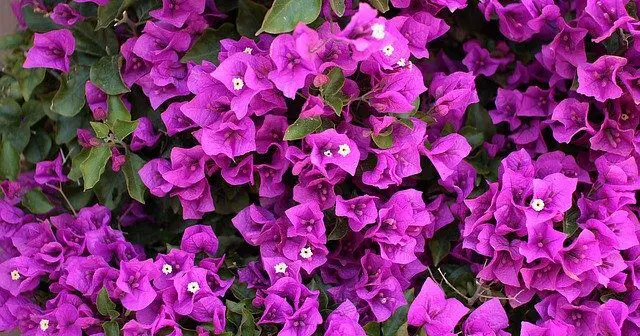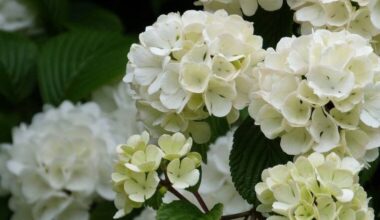The bougainvillea is a climbing plant that can reach 15 ft high. Native to Brazil, the bougainvillea can be grown as a shrub or a climbing liana, on a facade or a trellis.
The bougainvillea is remarkable for its brightly colored blooms in summer. It is about kinds of leaves or bracts, colored. We present 9 climbing plants, very similar to the bougainvillea, you can use them to replace it in your garden or composition.
Contents
9 plants that look like bougainvillea
1. Bignone (Campsis)
These plants cling alone thanks to their studs and have a great development (from 5m to 10m). The foliage is deciduous and the bloom intense during all the summer. The flowers look like big trumpets going from yellow to red. The hotter and sunnier the weather, the more abundant the bloom.
The common bignone (Campsis Radicans) resists well to the harsh winters of northern France up to about 5°F.
The very widespread variety x Tagliabuana “Mme Galen” has a salmon-red color with large flowers and that x Radicans “Flava” with yellow flowers, the narrow flowers are also smaller.
2. Clematis (Clematis)
It is the best known and most widely used of the climbers. This deciduous plant is very floriferous during several months of summer. The colors go from the white to the pink while passing by the blue and the purple.
The distinction is made on the type of flower, one distinguishes the small flowers (1 to 3 inches) from the large flowers (4-6 inches). Some will have double flowers and others single flowers.
It is necessary to plant in sunny or semi-sunny situation, but it is absolutely necessary to protect the foot of the plant from the sun on approximately 12-18 inches. It will be able to hold very well in a container because of its small development. Think of associating it with other plants by mixing it inside, or even to put it with a climbing rose.
The clematis Armandii is persistent with a very early white bloom around March.
The deciduous clematis Alpina with blue flowers also blooms around March.
3. Dipladenia (Mandevilla splendens)
This plant is originating in South America. So that its blooming is total it would need a soft climate, that is to say approximately 68°F the summer and 50°F the winter. It would thus reach 9 ft at adult size in these conditions.
This plant is frosty that is to say that below 32°F it does not resist.
In France it is cultivated for most of the time in pot where its development will be less.
Its foliage is persistent. This climber likes the full sun. Not having a tendril it is up to you to trellis it since it is not able to do so naturally.
Its large white, pink or red bells will flower abundantly from May until frost.
4. Glycine (Wisteria)
This climbing is often characterized by its vigor. Very floriferous but also fragrant, this climber needs sunshine to flower abundantly. It is a climbing plant which needs a solid support to be able to hang on. It is however able to wrap itself on it.
The existing varieties can measure between 15 and 45 ft high.
The white, blue or purple flowers are giant because they measure nearly 12 inches and are abundant from April to June depending on the region. Often when the bloom appears, very few leaves have come out.
Ideal on pergolas or arbors, they will make a wonderful shelter for the summer to keep you cool.
Be careful, this plant does not like calcareous grounds, nor too heavy and rich grounds which would rather support the development of the leaves.
One distinguishes mainly :
The most cultivated is the wisteria of China (Wisteria sinensis). It can be recognized by its leaves which have 7 to 13 leaflets and its flower clusters which are among the smallest (less than 12 inches).
Japanese Wisteria (Wisteria floribunda) has different leaves, much more divided with 13 to 19 leaflets.
The American Wisteria (Wisteria frutescens or Wisteria speciosa) are old varieties and not much cultivated today.
5. Ivy (Hedera)
It is one of the only evergreen climbers. This plant is very easy to set up, since it is appropriate for any type of exposure and any type of ground.
They are also used as ground cover, their crampon roots cling everywhere and allow a fast proliferation.
Hedera Helix is the basic variety used to produce all cultivars. Its leaves are dark green. This variety is very resistant.
The variety Hedera canariensis “Gloire de Marengo” is very well known for its large foliage variegated with white. Attention however with the strong frosts, to plant in full sun preferably.
The variety the most resistant to cold and which has a very fast growth is the Hedera Hibernica or also called Ivy of Ireland.
6. Passionflower (Passiflora)
Passionflower or “passion flower” is native to Africa so it is not very rustic.
Its foliage is evergreen, and its flowering is impressive by the size of the different elements that make up its flower.
Each flower will open in the morning with the first rays of sunshine and close again at the end of the afternoon. It will bloom only one or two days but is relayed by other buds which take the continuation.
This climber flowers from late spring to early winter in full sun, with varieties ranging from white, purple, pink, blue to purple.
Its tendrils allow it to cling alone to its support and to grow up to 15 ft in open ground.
This plant will hold perfectly in vat, which is preferable especially for the not very rustic varieties which one will be able to return easily in winter.
For the mild climates, you will be lucky to have fleshy fruits in autumn, of orange color which are quite edible. Prune short at the end of the stems which will probably have burned with the cold.
7. Sweet pea (Lathyrus odoratus)
This plant is very floriferous but lasts only one year since it freezes.
Often bought in seed, it is sown in spring as soon as the frosts are finished. The intense bloom can begin as of May for the areas with soft climate, until September in general.
Often sought after for its perfume, this climber likes in full sun. Little difficult to cultivate it likes very well in pot if necessary.
The diversity of colors is also an asset.
It needs a support to which its tendrils will attach themselves. Some can measure up to 12 ft if the plant was sown early and if the soil is rich. Lower or even dwarf species exist however.
8. Trachelospermum Jasminoides
It is also called false jasmine or persistent jasmine. Its development is average since its height does not exceed 9 ft high. Its foliage is evergreen, and changes color during the fall, going from dark green to reddish-bronze.
Its small white starry flowers have a bewitching perfume throughout the summer. This plant likes an exposure of full sun and thrives in rather sheltered places because of its weak hardiness.
9. Trachelospermum Asiaticum
All the characteristics are identical to the Jasminoides variety except the color which is pearly-yellow.









